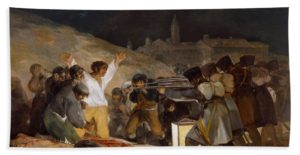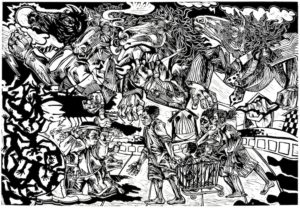During the Teaching Assistants’ lecture on March 11, 2019, they mentioned a painting titled The Third of May by a Spaniard named Francisco Goya created in 1808. In my last blog post, I mentioned how the TA’s connected it to the Steve Prince art piece Stand at the Gretna Bridge because he used Goya’s painting in reference to his creation. However, in my last blog post, I did not have time to unpack everything about Prince’s composition. Therefore, for this blog post, I will attempt to unpack the art piece to the best of my ability.

The Third of May by Francisco Goya

First, historical context of the artwork. Prince encapsulates a horrific moment in America’s history. In New Orleans, there was supposed to be a severe Hurricane called Katrina heading towards the city. Therefore, it was advisable for people to evacuate the city. In Columbia Journalism Review, an article by Edward B. Colby states that on September 6, 2005, hundreds of people were fleeing the city thinking if they could get to Mississippi they will take buses to get them out of town. However, when two EMS workers approached the bridge, they report that they were met with “[A]rmed sheriffs [who] formed a line across the foot of the bridge.” These two EMS workers recall, “Before we were close enough to speak, they began firing their weapons over our heads. This sent the crowd fleeing in various directions.” When the people approached the officers they said “that the West Bank was not going to become New Orleans, and there would be no Superdomes in their city.” This translated to the EMS workers’ interpretation of what the police officers said to them: “[I]f you are poor and Black, you are not crossing the Mississippi River, and you are not getting out of New Orleans.”
Now, how does this racist act correlate to a painting in 1808? Well, during this time era, according to Khan Academy, Napoleon was on a mission to conquer the world and made a fake alliance with Spain to conquer the country. Therefore, on the 2nd of May, 1808 hundreds of Spaniards rebelled to protect their country. Then, on May 3rd the Spanish freedom fighters “were rounded up and massacred by the French.” Goya depicts the massacre and slaughter of his countrymen in his painting. It is the world’s first modern painting.
So, why does Prince use Goya’s art piece to influence his composition Stand at the Gretna Bridge? Well, I believe his intentions for his art piece was to show the massacre committed on that bridge that day. Although nobody was shot or massacred like the Spaniards in 1808, the people fleeing New Orleans were about to be slaughtered by the deadly hurricane coming. Instead of receiving sanctuary the people were met with weapons. In Goya’s painting, I see the Spaniards’ faces and the men who were already dead. They are met on the other side of the canvas with guns from the French. In Prince’s composition, he has children and families carrying their worldly possessions trying to seek refuge. But, just like the Spaniards, they are met with guns by police officers and malicious dogs on the other side.
While analyzing Prince’s woodblock piece during class, I noticed how in both Goya’s painting and Prince’s artwork their focal point is the person holding their palms out saying “I am innocent. I mean no harm.” Goya has the focal point’s arms up in the air while Prince has his down towards the ground. Although very subtle, I noticed that similarity of movement in both pieces to try and understand the intention of Prince’s artwork. Despite the actual movement being different, the gesture still has the same meaning of peace and no harm.
Although I cannot read Prince’s mind I attempted to analyze and unpack the meaning of Goya’s painting and the meaning behind the event at Gretna Bridge. Just as SUNY Geneseo’s curator Hawkins-Owen mentioned how artists choose to depict what story they want to tell through their works, I believe Prince highlights two sides of the story: one side being civilians trying to find refuge, and the other being law enforcement not helping them. This artwork reminds me of the veil in W.E.B. Du Bois The Souls of Black Folk. In it, he mentions how there is always a veil that covers him and the rest of society. Always a veil that creates division and does not move towards progress in society. Interestingly enough Prince’s full title of his composition is Katrina’s Veil: Stand at the Gretna Bridge. In my opinion, this easily forgotten part of the title alludes to the same kind of casting of prejudice and divide based on a color of the skin which Du Bois refers to in his discussion of the veil in The Souls of Black Folk. The veil in Prince’s title both gestures to Du Bois interpretation of America casting a veil upon society and Katrina’s illumination of the veil persisting in twenty-first century America.
